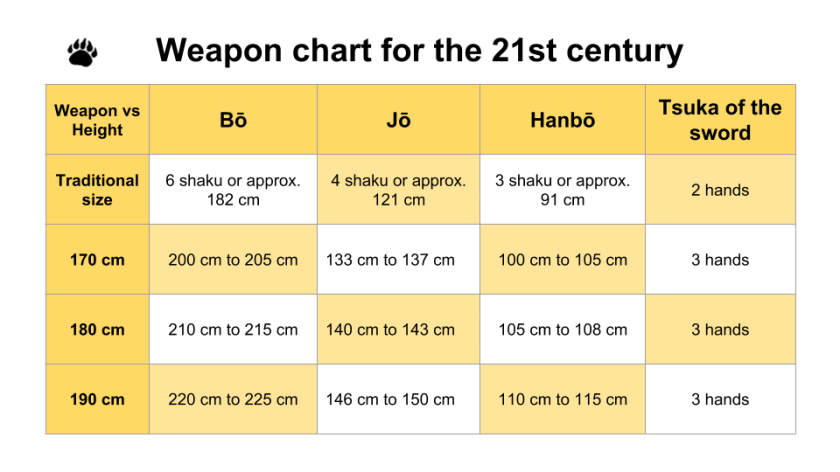
Did you ever walk with shoes too small for your feet? It is painful, even if they look good.
Well, I see a similarity with the weapons we use in the Dōjō. Many of the weapons we use are undersized. Tradition is beautiful, but sometimes it can be counterproductive. I will explain why in this post.
- First, what we call the “Japanese martial arts” developed out of necessity. Between the Heian period (1185), and the forced peace at Sekigahara battle (1600), Japan was at war. (1)
- Second, Japanese people were small. The founders of Gendai Budō (Jūdō, Aikidō, Karatedō) were all three, around 150cm in height! (2) We can surmise that was the case for the majority of the Japanese people.
- Third, in the Kanejaku system of measures, the central size is the Ken (6 Shaku, app. 182 cm), and every building in Japan follows this system of length. (3) Shakkanhō is the name of this global system of measures. (4)
A Ken being six shaku that gives a size of 6 x 30.3 cm = 181.81 cm (or 5.9652 feet)
For the sake of our demonstration, we will keep the value of 1 ken = 180 cm.

If the average Japanese man of the past was 150 cm tall (5), the Europeans of today are around 172 to 181 cm. (6) We have to adjust the sizes of the weapons we use.
Keep in mind that a soldier will always have a weapon he can use to defend himself. And about the long arms, the longer, the better to keep the opponent out of reach. Musashi did the same when fighting Kojiro. He used an oar as a bokken to match the length of his opponent’s Nodachi. (7)
The Japanese Bō is 180 cm. That means the size of the weapon is 20% longer than the body size. (8)
So the size of our Bō should be between 200 cm and 220 cm!
That is pure math, but you should consider training with weapons for your size. Keeping the “traditional” format for the weapons just doesn’t make any sense.
I am 176 cm tall; my Bō should be 210 cm. I use a Bō of 2 meters, and I find it correct to train. My Hanbō is 105 cm, and my Jō is 140 cm.
To sum up, many of you train with a Bō too small for them. Your Hanbō looks like a cane for old people, and your Jō is about 20 cm too short.
- A Bō is six shaku + 20%
- A Jō is four shaku + 20%
- A Hanbō is three shaku + 20%
When in Japan, I spoke with Toomas, the founder of Soft Hanbō Ltd. He creates and sells the best Europeans padded weapons we can use in the Bujinkan. The last trip, he gave a set of padded weapons to Sensei, who was so pleased that he gave him one of his iaitō in return!
After speaking together, he might create longer training weapons suiting our body size. Check with him on his new website. (10)
Here is a chart you can use to find your perfect weapon size:

Test different sizes to see which one works for you. The dimensions here have to be adapted to your height, length of limbs, torso, etc. Find the perfect match for you.
I added the size of the Tsuka in the chart above. The blade is essential but what is even more important is the size of your Tsuka. Because of the Yoroi, the size of your Tsuka should be the width of your torso. With a long Tsuka, you do not injure the inner side of your arms. You can also extend your arms better. The small Tsuka we have on the bokken or swords is coming from the Edo period where the Yoroi was no more in use.
So, grow the size of your weapon, because you know now that size does matter!
________________
1. Dan no Ura (1185): https://en.wikipedia.org/wiki/Battle_of_Dan-no-ura
Sekigahara (1600): https://en.wikipedia.org/wiki/Battle_of_Sekigahara
2. Gendai budō (現代武道): https://en.wikipedia.org/wiki/Gendai_bud%C5%8D
3. Kanejaku: https://www.sljfaq.org/afaq/units.html
5. They began to grow in height during the 20th century. My first trip to Japan was in 1990. I am 176 cm, and I remember that on the train I was taller than most of the locals. Not anymore, regular proteins input changed that.
6. Average European Height for males: https://blog.cliniccompare.co.uk/tallest-men-in-europe
7. Musashi vs Kojiro: https://en.wikipedia.org/wiki/Sasaki_Kojir%C5%8D
8. 150 cm x 1.2 = 180 cm
9. Modern European size for a Bō: 172 cm x 1.2 = 206.4 cm to 181 cm x 1.2 = 217 cm!
